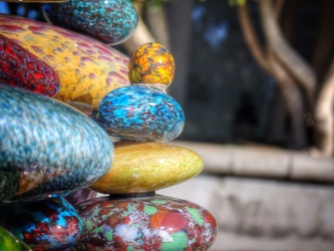
Chris Moore, Bird Songs (painted steel, corten steel, stainless steel). Seen at Sculpture in the Gardens 2015/16, Auckland Botanic Gardens, New Zealand. Image: Su Leslie, 2016
Art is optimism made manifest. To write a poem, paint a picture, compose music or shape materials into a physical expression of an idea; for me these things entail a hopefulness about the future.
Sculpture seems to me a particularly optimistic art form. It is often large in scale and can require a lot of expensive materials. The artists need great skill, a lot of time and plenty of money to make work. Sometimes they receive a commission, but more often make work because they have to; because the creative impulse is too strong to ignore.

Bing Dawe, Titipounamu – A Necklace With Lost Gems (Laser cut steel, bronze). Seen at Sculpture in the Gardens 2015/16, Auckland Botanic Gardens, New Zealand. Image: Su Leslie, 2016
The three works shown in this post are all being exhibited at the moment at the Auckland Botanic Gardens as part of the biennial Sculpture in the Gardens. The exhibition, which champions New Zealand artists, runs for a three-month period and is free for visitors. The works exhibited are for sale, and some are bought by the Friends of the Auckland Botanic Gardens to become part of the permanent collection.
Neither Chris Moore’s ‘Bird Songs‘ nor Bing Dawe’s ‘Titipounamu‘ is a particularly optimistic work thematically. Both lament the loss of bird species in New Zealand and elsewhere. But both are very large-scale works in steel which have taken enormous effort as well as vision to create. They draw our attention to the problem, but do so through beauty and creative talent.

Garry Nash, Waypoint, (blown glass, stainless steel, glue, sand). Seen at Sculpture in the Gardens, 2015/16, Auckland Botanic Gardens, New Zealand. Image: Su Leslie, 2016
Glass artist Gary Nash’s ‘Waypoint‘ of blown glass shapes is a truly optimistic work, with its clever stacking of delicate glass in what appears to be a somewhat precarious cairn.
Like the art on display, exhibitions such as Sculpture in the Gardens require optimism, and a belief in the power of art to improve the lives of people who experience it.
This post was written for the Daily Post Photo Challenge. This week the theme is optimistic.


Cool!
LikeLiked by 1 person
Ooh, pretty rocks. Come visit my blog 🙂
LikeLike
Thanks for the tour of sculpture…I adore cairns with Andy Goldsworthy as the quintessential land artist to create them.
LikeLiked by 1 person
I love Andy Goldsworthy’s work. I’ve seen it at the Yorkshire Sculpture Park and also at Gibbs Farm north of Auckland. 🙂
LikeLike
Gorgeous works! I love the birds in flight! 🙂
LikeLiked by 1 person
Thanks. It is a beautiful sculpture; not sure I really did it justice but it was mounted up high and I’m not very tall 🙂
LikeLiked by 1 person
You did a great job. 🙂
LikeLiked by 1 person
Thank you 🙂
LikeLiked by 1 person
Lovely entry photos!
Thanks for stopping by my little place, too!
LikeLiked by 1 person
Thank you — and you’re welcome 🙂
LikeLike
Beautiful works of art – thanks for sharing them with us
LikeLiked by 1 person
Thanks Raewyn. It’s a pretty cool exhibition. So much good outdoor art at the moment!
LikeLiked by 1 person
Oh, love that Waypoint sculpture!
LikeLiked by 1 person
Isn’t it cool. I love Gary Nash’s work, though it’s gone up a lot in price since I began buying glass art, so what I own of his is all pretty old now.
LikeLiked by 1 person
Su, what a great response to optimistic!
LikeLiked by 1 person
Thanks Sue. I was walking around the exhibition, thinking about the investment the artists had made in time and materials, knowing the work might never sell … and if that’s not optimism,what is?
LikeLiked by 1 person
Absolutely! 😀
LikeLiked by 1 person
How beautiful.
LikeLiked by 1 person
Excellent post, Su and so true. And I couldn’t believe that Waypoint sculpture was made of glass. It’s stunning.
LikeLiked by 1 person
Thank you. I thought at first it was ceramic; it wasn’t until I got close (and saw who the artist is) that I realised. It just plays so nicely with everything we expect from a cairn — colour, weight and stablility.
LikeLiked by 1 person
So lovely to see these works. Most public sculpture makes me feel optimistic,partly because it shows that creativity persists, and that a community is well enough and peaceful enough to welcome that persistence.
LikeLiked by 1 person
That is a really good point about the community around art; I hadn’t thought about it, but you are right. Thanks for adding an extra dimension to my thinking about this. 🙂
LikeLiked by 1 person
Mesmerised by the inspirational sculptures and your competent photography as well as by your thoughts on Art!Happy Tuesday,dear Su 🙂 xxx
LikeLiked by 1 person
Thank you Doda my friend. xx
LikeLiked by 1 person
🙂 xxx
LikeLiked by 1 person
Pingback: 2016: a personal retrospective | Zimmerbitch
This is lovely.
LikeLike